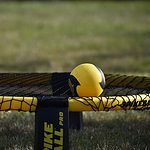Imagine stepping onto a pickleball court, the crisp lines defining the boundaries, the net standing tall in the center.
Curious about the specific dimensions that make up this unique playing area? Understanding the size of a pickleball court is crucial for players looking to enhance their skills and strategic gameplay.
From the length and width of the court to the non-volley zone measurements, each aspect plays a significant role in the dynamics of the game.
But what other key details should you be aware of to master the court?
Key Takeaways
- Pickleball courts are 20 feet wide and 44 feet long with a net height of 34-36 inches.
- Specific features like the non-volley zone and service areas enhance strategic gameplay.
- Court line measurements ensure fair play and consistent boundaries for players.
- Comparing to tennis courts, pickleball courts are narrower but offer unique gameplay dynamics.
Standard Pickleball Court Dimensions
Measuring 20 feet in width and 44 feet in length, a standard pickleball court adheres to specific dimensions for competitive play. The net stands at a height of 34 inches at the center and 36 inches at the sidelines. This setup ensures fair play by maintaining consistency in the game.
The non-volley zone, positioned 7 feet from the net, acts as a barrier to prevent players from executing smashes right at the net. The service areas, each 15 feet long and 10 feet wide, are crucial zones for initiating gameplay.
These official dimensions guarantee that pickleball court measurements are in line with regulation size, promoting a level playing field. By following the size requirements meticulously, players can count on a standardized court that upholds the principles of the game.
The emphasis on the pickleball court's dimensions underscores the importance of accuracy and uniformity in competitive pickleball matches.
Length of Pickleball Court
The standard length of a pickleball court provides a designated area for competitive play, ensuring strategic gameplay and fair competition. A pickleball court is 44 feet long, a dimension that remains consistent for both singles and doubles play. This length allows players to engage in dynamic movements while strategically positioning themselves on the court. The 44-foot length, combined with the court lines, creates boundaries that players must navigate efficiently during matches.
The total minimum play area required for a pickleball court is 60 feet long, with the recommended length being 64 feet for optimal gameplay. This additional space beyond the standard length enhances player movement, enabling them to execute various shots and tactics effectively. The length of a pickleball court plays a crucial role in competitive play, offering players the opportunity to showcase their skills through strategic positioning and agility.
Width of Pickleball Court
Narrow in design, the standard width of a pickleball court spans 20 feet. When considering the width of a pickleball court, it's crucial to understand its impact on the game. Here are some key points to note:
- Strategic Gameplay: The 20-foot width of a pickleball court promotes strategic gameplay by requiring players to be precise in their shots and movement. It challenges players to think tactically and quickly adapt to the compact playing area.
- Quick Movement: The narrow width encourages swift and agile movement across the court. Players need to cover the width efficiently to return shots effectively and maintain control of the game.
- Effective Coverage: Despite the narrow width, the court allows players to effectively cover the playing area. This feature enhances the dynamics of the game, leading to engaging rallies and exciting exchanges.
- Distinct Feature: The 20-foot width is a distinctive feature of pickleball courts, setting them apart from other sports courts and contributing to the unique charm of the game.
Non-Volley Zone Measurements
Incorporating the strategic gameplay elements of a pickleball court's width, the non-volley zone measurements play a pivotal role in dictating player movements and shot selections during a game. The non-volley zone, also known as the kitchen or the touch zone, is 7 feet deep on each side of the net.
This designated area restricts players from volleying the ball while standing within this zone, emphasizing tactical positioning and precise shots. By enforcing this rule, the non-volley zone prevents players from executing aggressive volleys or smashes too close to the net, fostering a more controlled style of play.
Players must strategically maneuver around the court to avoid stepping into the non-volley zone when volleying the ball. This zone heightens the importance of strategic gameplay, encouraging players to plan their moves carefully and execute shots precisely.
Pickleball Court Line Dimensions
Taking into account the standard dimensions of a pickleball court, the line measurements play a crucial role in defining the boundaries for fair and consistent gameplay.
- Net Height: The net stands at a height of 34 inches at the center and 36 inches at the sidelines, ensuring proper clearance for gameplay.
- Non-Volley Zone: Situated 7 feet from the net, the non-volley zone creates a fair playing area where players can't hit volleys.
- Service Areas: Each side of the centerline features service areas that are 15 feet long and 10 feet wide, providing designated spaces for serving.
- Court Boundaries: The overall dimensions of 20 feet in width by 44 feet in length, along with the centerline, establish the proper court boundaries for pickleball gameplay.
These precise line measurements not only delineate the court but also contribute to maintaining the integrity of the game, ensuring that players adhere to the rules and enjoy a competitive yet fair match.
Importance of Court Size Accuracy
Precision in court size accuracy is fundamental for maintaining the integrity and fairness of pickleball gameplay. The dimensions of a pickleball court play a crucial role in ensuring a level playing field for all participants. Accurate court dimensions provide players with the necessary space to execute shots effectively and strategically.
When the court size is consistent and precise, it minimizes disputes and promotes fair competition. Players rely on the standardized court dimensions for positioning themselves optimally during gameplay, influencing their movement and shot selection. Skill development in pickleball is greatly facilitated by playing on courts with accurate dimensions, as it allows for a consistent playing experience across different locations.
Moreover, tournament planning hinges on the adherence to correct court sizes to guarantee fair matches and strategic play. Therefore, maintaining accurate court dimensions isn't only essential for the integrity of the sport but also for fostering a competitive and skill-enhancing environment for players.
How to Properly Measure Court Dimensions
To accurately measure the dimensions of a pickleball court, start by using a measuring tape to mark the standard size of 20 feet wide by 44 feet long. Ensure the net height is 36 inches at the sidelines and 34 inches at the center for proper setup. The non-volley zone should be 7 feet from the net to maintain the required playing area. Mark the service areas as 10 feet wide and 15 feet long on each side of the centerline. Adhere to the recommended dimensions to create a fair and enjoyable pickleball court experience.
When measuring the court, precision is key to ensuring a proper setup that aligns with the standard dimensions. Use the measuring tape diligently to mark the court's boundaries accurately. Pay attention to the net height, ensuring it's set correctly at 36 inches on the sidelines and 34 inches at the center. Establish the non-volley zone at a distance of 7 feet from the net, and mark the service areas to be 10 feet wide and 15 feet long on each side of the centerline. Following these steps will guarantee a pickleball court that meets the recommended dimensions for fair play.
Creating Temporary Court Lines
If you plan to create temporary court lines for a pickleball game, utilizing chalk or tape on a flat surface is a practical method. When drawing these lines, ensure they're 2 inches wide to enhance visibility and accuracy during play.
It's crucial to mark out the non-volley zone and service boxes accurately to maintain the integrity of the game. Video tutorials can be a helpful resource for guiding you through the process of drawing temporary pickleball court lines, offering step-by-step instructions for precision.
Additionally, stencils can be utilized for creating permanent court lines if you're looking for a more long-term solution. By following these guidelines and using the right tools, you can set up temporary court lines efficiently and effectively, providing a clear and defined playing area for your pickleball games.
Pickleball Court Boundary Zones
When marking out the boundaries of a pickleball court, ensure to accurately define the non-volley zone, service areas, and kitchen for proper gameplay. Here are key points to consider:
- Non-Volley Zone: The non-volley zone in pickleball is crucial, spanning 7 feet on each side of the net. Players must avoid volleying the ball while inside this zone to maintain fair gameplay.
- Service Areas: The service areas on a pickleball court measure 15 feet long and 10 feet wide. These designated zones are where players must serve the ball from, ensuring consistency in serving.
- Kitchen: The kitchen, also known as the no-volley zone, extends 14 feet from the net. Players aren't allowed to volley the ball while standing in this area, adding a strategic element to the game.
- Minimum Play Area: To accommodate proper gameplay, a minimum play area of 30 feet wide by 60 feet long is recommended for a pickleball court, providing ample space for movement and shot placement.
Comparing Pickleball and Tennis Courts
Comparing the dimensions and layout of pickleball and tennis courts reveals distinct differences in size, net height, and playing areas, influencing gameplay strategies and shot selections. Pickleball courts are smaller than tennis courts, with dimensions of 20 feet wide and 44 feet long compared to tennis courts, which are 36 feet wide and 78 feet long. The net height on a pickleball court is set at 34 inches at the center and 36 inches at the sidelines, slightly lower than the 36-inch net height on a tennis court. Both pickleball and tennis courts have specific markings and dimensions for singles and doubles play, with pickleball courts accommodating both formats within the same dimensions. When setting up pickleball on a tennis court, temporary lines and portable nets can be used to align with the larger tennis court orientation for gameplay. These differences in playing area and net height between pickleball and tennis courts significantly impact how the games are played, requiring players to adapt their strategies accordingly.
| Aspect | Pickleball Courts | Tennis Courts |
|---|---|---|
| Court Width | 20 feet | 36 feet |
| Court Length | 44 feet | 78 feet |
| Net Height | 34 inches at center, 36 inches at sidelines | 36 inches |





